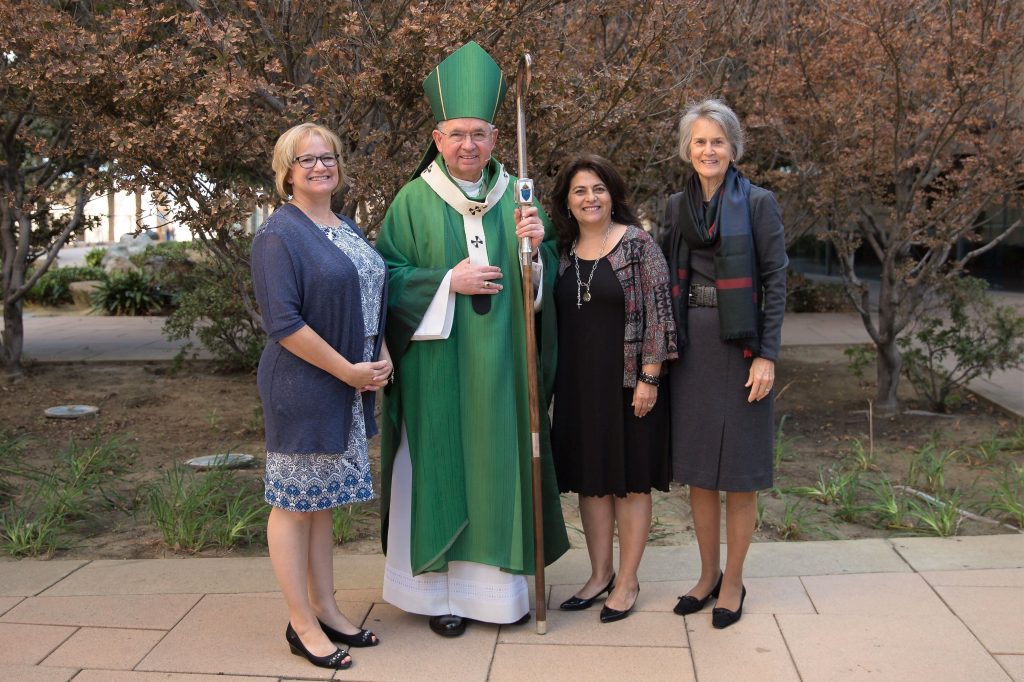Thirtyrnyears ago Suzette Sornborger was a college graduate looking for a job — littlernknowing that her first job would start her on a path of service for the Church,rnwhich would mean trading one ministerial job for another, moving from parish tornparish, until she would finally be commissioned as a pastoral associate.
“Irnwon’t have the official title until after Sunday,” Sornborger said before herrnrecent commissioning. Although her role at St. Monica Church in Santa Monica won’trnchange drastically, she has served under the title director of faith formation inrnthe few months leading up to the ceremony. On July 1, Sornborger assumed thernrole Sister Catherine Ryan held before her retirement.
Thernterm “pastoral associate” can only be given to someone who has beenrnspecifically commissioned as such by the bishop of the diocese. Pastoralrnassociates work closely with a parish pastor to oversee decision-makingrnresponsibilities and assist in the formation of the congregation. On Nov. 5, ArchbishoprnJosé H. Gomez commissioned Sornborger and Katie Tassinari as pastoralrnassociates at the Cathedral of Our Lady of the Angels.
KatherinernEnright, the director of the office of parish life for the Archdiocese of LosrnAngeles, stressed that the Church needs laymen and women to respond to the callrnof service, noting, “The call to serve the Body of Christ is [for] everyone whornis baptized.”
“Irnnever really imaged myself doing this kind of work when I first got out ofrncollege,” Sornborger said. “So you just never know where God wants you, andrnbeing a willing listener to forge ahead with that has been such a delight.”
Sornborgerrnand Tassinari were carefully vetted. Pastoral associates must hold a master’s degreernin divinity or in pastoral, theological or religious studies and have had yearsrnof experience serving in a parish.
Sornborgerrnis part of a group of six church administrators, which include the pastors, whornserve the parish’s more than 8,000 families. The group works closely togetherrnto manage anything from finances to spiritual care. “Everyone has a voice,”rnSornborger said. “It’s a wonderful process.”
Thernneeds of each parish are “wildly different” Enright said, noting that there arernmany cultures, traditions and ministries that are in need of leadership,rnespecially in light of the ongoing priest shortage. She lists music ministries,rnbereavement ministries and family catechesis as a few of the many necessary spiritualrnworks in the Church.
Asrna wife and mother, part of Sornborger’s challenge will be drawing boundaries onrnthe hours she spends on the job. She tries to limit her work schedule to 50rnhours per week. “There’s a definite expectation for me to be available as muchrnas the monsignor needs to be available, particularly in spiritual counseling,”rnshe said.
SincernVatican II, more laywomen have responded to the call to serve the Church,rnbecoming theologians or receiving graduate degrees in divinity studies. PopernFrancis is encouraging this movement. In “Evangelii Gaudium,” he wrote, “Wernneed to create still broader opportunities for a more incisive female presencernin the Church.”
AlthoughrnPope Francis wants women to take on more responsibilities in the Church (whilernacknowledging that only men can be ordained priests), he also seems to implyrnthat their specific form of service is yet to be properly determined.
Earlierrnin 2013, the pope said during a press conference, “The role of women in thernchurch must not be limited to being mothers, workers, a limited role. … No! Itrnis something else.”
And so, beginning Nov. 6, Sornborgerrnassumed a new role where she joins other women in discovering how much morernthey can give.
Interested in more? Subscribe to Angelus News to get daily articles sent to your inbox.

